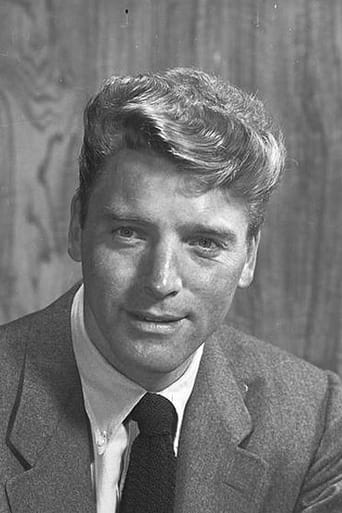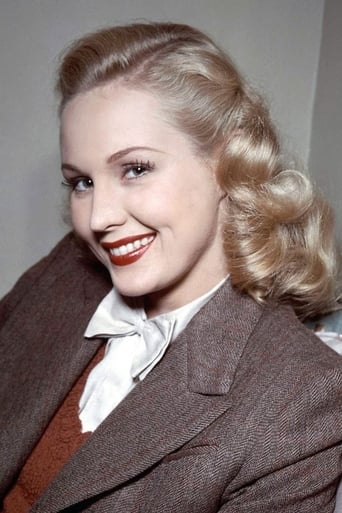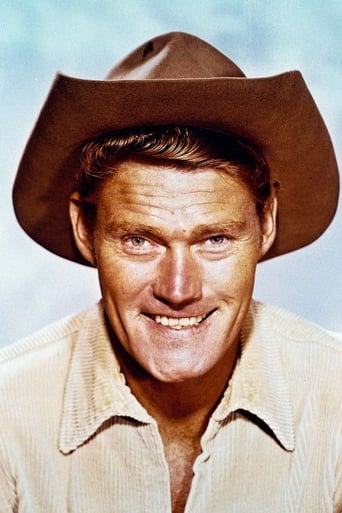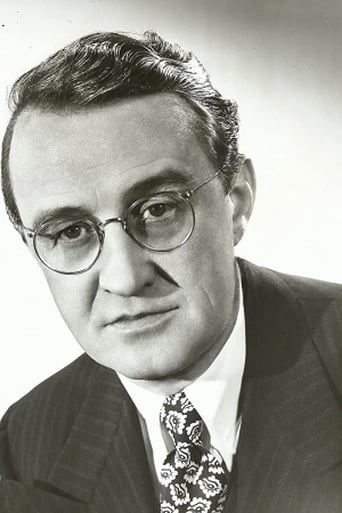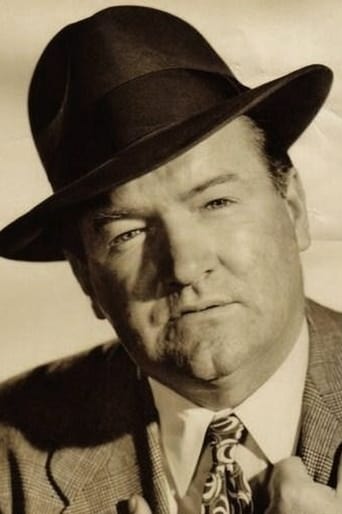Stevecorp
Don't listen to the negative reviews
Merolliv
I really wanted to like this movie. I feel terribly cynical trashing it, and that's why I'm giving it a middling 5. Actually, I'm giving it a 5 because there were some superb performances.
Donald Seymour
This is one of the best movies I’ve seen in a very long time. You have to go and see this on the big screen.
Zandra
The movie turns out to be a little better than the average. Starting from a romantic formula often seen in the cinema, it ends in the most predictable (and somewhat bland) way.
James Hitchcock
In 1944 U.S. Marine Master Gunnery Sergeant James O'Hearn is facing a court martial for desertion, theft, scandalous conduct and destruction of property, charges which in time of war carry the death penalty. ("Scandalous conduct" in this context means sex outside marriage; if that were to be regarded as a capital offence under military law I suspect that the fighting strength of most of the world's armies would be drastically reduced overnight). The above might suggest that this is a serious courtroom drama along the lines of "The Caine Mutiny". Admittedly, the film starts off in serious vein, but as soon as Ginger Martin (she with whom O'Hearn allegedly conducted himself scandalously) takes the stand seriousness goes out of the window and it descends into ridiculous comedy.Ginger is presumably the "South Sea Woman" of the title, but she is actually a white American rather than a Polynesian and only finds herself in the South Seas by chance. When O'Hearn first meets her she is working as a showgirl at a nightclub in Shanghai, where his regiment is stationed, and is the girlfriend of his friend Private Davy White. An attempt by White to slip away to marry Ginger leads to the three finding themselves adrift at sea on a small motor boat. In a series of increasingly farcical misadventures, in the course of which they inadvertently commit the acts which will form the basis of the charges against O'Hearn, they are rescued by a Chinese junk and eventually cast away on the French-ruled island of Namou. As the Governor of Namou is pro-Vichy, and as the attack on Pearl Harbor has now brought America into the war, the two Marines have to pretend to be deserters in order to avoid being interned. White and Ginger attempt to marry several times, but are always frustrated. It is at this point that the film changes direction again, largely abandoning comedy and turning into a patriotic wartime adventure as O'Hearn and White discover a fiendish Nazi plot and decide to take action to thwart it, to seize a boat and to rejoin the Marines who are fighting the Japanese at Guadalcanal. Mixing genres in this way is often a risky business, the risk being that the resulting film can end up as neither fish nor flesh nor fowl nor good red herring, or in this case neither drama nor comedy nor action. I don't think there was ever any possibility of this film being a sort of "Caine Mutiny Court Martial", but it could certainly have been made either as a comedy about the adventures of a pair of bungling Marines and a girl or as a standard gung-ho action war film about two heroic Marines with a sub-plot about their love-interest. The attempt to make the film as a combination of these two approaches simply results in a misbegotten dog's breakfast, a film which is not very amusing when it tries to be a comedy and not very exciting when it tries to be a wartime adventure. About all one can say for it is that Virginia Mayo looks lovely, as she normally did. This is not quite Burt Lancaster's worst movie; he normally saved his worst for those occasions, mostly in the sixties and seventies, when he allowed his political judgement to overcome his artistic judgement and ended up playing a villainous right-wing fanatic in turgid, paranoid left-wing thrillers like "Executive Action" or "The Cassandra Crossing". It is not, however, one of his better ones, and is one that is probably best forgotten by all but the most obsessive Lancaster fans. 4/10
bkoganbing
In a recent biography of Burt Lancaster the only two things that were mentioned about South Sea Woman was that it enabled him to fulfill a commitment to Warner Brothers on a three picture deal and that he was instrumental in getting Chuck Connors the part of his fellow Marine in hijinks. Other than that this one is strictly minor league Lancaster.The title role of South Sea Woman is played by Virginia Mayo who the two have a rivalry over. The story is narrated from several perspectives at a court martial that Lancaster is undergoing. These two manage to miss the withdrawal of Marines from Shanghai which occurred a few weeks before Pearl Harbor. Lancaster wants to get back to the outfit especially when they get news of the Japanese attack, but Connors has Mayo on his mind, he wants to get married.Not since the Errol Flynn film Desperate Journey also by Warner Brothers was there ever a more lighthearted approach to war. These two guys also manage to liberate a Vichy governed French colony and turn it over to the Free French and from said island recruit a crew to get to Guadalcanal where they do distinguish themselves in their own private action. All this related to a rather incredulous court martial board. What was interesting was that Burt Lancaster did two films at once. While this was shooting Lancaster went over to the set of Three Sailors And A Girl and did a small walk-on role in his Marine uniform costume in that musical. With that he fulfilled a three picture commitment the other being The Flame And The Arrow in which he also co-starred with Virginia Mayo. The comedy was kind of forced and while it had a few laughs in it South Sea Woman is clearly a film that Lancaster wanted to get off his plate and move on. That year of 1953 he also did From Here To Eternity a much better film about the start of the Pacific War.
howardmorley
I found my way to this film after seeing Veola Vonn playing "Arlette" a voluptuous painter's model in "Le Fantome de la rue Morgue" (1954) which is loosely based on an Edgar Allan Poe novel.On looking at Veola's film career she seemed to specialise in acting roles playing French ladies of easy virtue and the subject film is typical when she plays Lillie Duval a madame of a brothel on a remote French island.Although she was born in NYK.(1918-1995), I wondered whether she had French parents/relatives or connections to give substance to these roles.Virginia Mayo first came to my attention in "The Best Years of Our Lives" (1946) playing the initially good-time wife of Dana Andrews a returning bombardier officer from the U.S.A.F. being demobbed at the end of WWII.In this film Virginia as "Ginger Martin" shows off her very feminine figure to its best advantage and soon gets Chuck (The Rifleman) Connors (Pvt.Davey White) & Burt Lancaster (Sgt. O'Hearn) squabbling over her and how best to get back into WWII on the side of Uncle Sam.For Burt it must have made a change doing this knockabout comedy after filming the heavy dramatic acting required playing another sergeant in "From Here To Eternity (1953)" in the same year.Coincidentally both films have the Japanese attack on Pearl Harbour as a theme.Another face I spotted was Paul Burke (The Naked City - 1960s TV series) playing an ensign at Sgt.O'Hearn's court marshal.Obviously the plot outlined in other user comments above is comedic and Hollywood stereotypes abound which include (from an American perspective,) all foreigners who cannot speak English but we must remember that these films were produced by Americans for average Americans.I would place the growing international maturity of U.S. film producers from 1962 with "The Longest Day".One obvious editing device used in "South Sea Woman" is to utilise B&W war newsreels of the real WWII U.S./Japanese conflict and splice them into the subject B&W film. Also used were back-projection screens with "real" studio action by the actors.Oh well, c'est la guerre.I rated it 6/10 on purely on an entertainment level.
MARIO GAUCI
The least significant entry in Warners' 5-Disc "Burt Lancaster Signature Collection" is this obscure but harmless WWII action comedy that is sufficiently enjoyable without being remotely memorable. The film starts out with Lancaster refusing to defend himself in the court-martial he is facing and the events unfold in flashback as the various witnesses give their testimony: Lancaster is a U.S. marine who (together with his pal Chuck Connors and the latter's fiancée Virginia Mayo) 'deserts' to a tropical island on the eve of the Pearl Harbor sneak attack where they proceed to live it up over there for a while, in the company of local madame (Veola Vonn), her three nieces and assorted beachcombers (including Arthur Shields). However, when a Dutch captain visits the island on his yacht, Lancaster and Co. steal it to go "have a crack at those Japs" – to borrow Errol Flynn's famous last words in Raoul Walsh's DESPERATE JOURNEY (1942); this leads to a rousing action climax in which the renegade band of islanders take on the Japanese fleet and manage to sink one of their ships – with Connors sacrificing his life in the process and leaving the way open for the budding romance between Lancaster and Mayo (reunited here three years after their joint participation in Jacques Tourner's colorful adventure, THE FLAME AND THE ARROW) to bloom. Two final things worthy of note: a young Strother Martin is clearly recognizable sitting next to Mayo in the courtroom and the eventual fate of the seaside dive might well have inspired a similar incident in, of all things, PORKY'S (1982)!!

